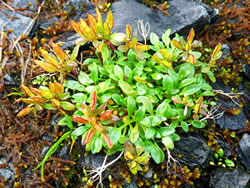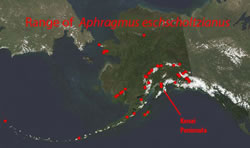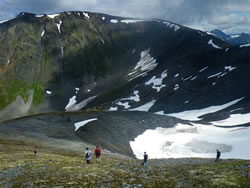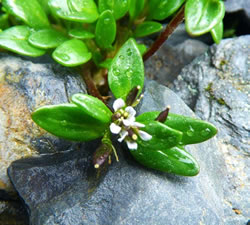Aleutian Cress Relocated on the Chugach National Forest, Alaska
 Aleutian cress plants are tiny, this plant is about 2 ½ inches tall. Note the current year's seed capsules and the ghosts of last year's seed capsules. Photo by Timm Nawrocki.
Aleutian cress plants are tiny, this plant is about 2 ½ inches tall. Note the current year's seed capsules and the ghosts of last year's seed capsules. Photo by Timm Nawrocki.
 The red points on this map indicate Aleutian cress' worldwide distribution. Photo by Timm Nawrocki.
The red points on this map indicate Aleutian cress' worldwide distribution. Photo by Timm Nawrocki.
 Botanists in Kenai Peninsula's alpine habitats looking for Aleutian cress. Photo by Timm Nawrocki.
Botanists in Kenai Peninsula's alpine habitats looking for Aleutian cress. Photo by Timm Nawrocki.
 Aleutian cress has tiny four-petaled, white flowers. On this plant, some of the flowers have already gone to seed. Photo by Timm Nawrocki.
Aleutian cress has tiny four-petaled, white flowers. On this plant, some of the flowers have already gone to seed. Photo by Timm Nawrocki.
By Mary Stensvold and Timm Nawrocki
Aleutian cress, also known as Eschscholtz's little nightmare (Aphragmus eschscholtzianus) is a rare, charismatic and tiny mustard that grows in alpine habitats. Its range extends across the Aleutian Islands, Kodiak Island, Kuskokwim Mountains, east along the Alaska Range and Wrangell St. Elias Mountains to the southern Yukon Territory and into the Tatschenshini River area of British Columbia; there are also disjunct populations on Alaska's Seward Peninsula and in the Brooks Range.
In July of 1951, James Calder, a Canadian botanist, discovered a population of the plant on the Chugach National Forest. The plants were growing on the northern part of the Kenai Peninsula in a wet, rocky subalpine valley. He collected specimens, pressed and dried them and sent a specimen to the herbarium (pressed plant collection) at the Department of Agriculture in Ottawa, Canada.
In 1991, John DeLapp, an Anchorage botanist at the Alaska Natural Heritage Program was investigating rare plant information for Alaska's Chugach and Tongass National Forests. During his studies he saw the pressed plant specimen and found that the Kenai Peninsula population was the only population of Aleutian cress known to grow on National Forest lands. Since 1951, many detailed plant surveys have been conducted in alpine habitats and no other populations of this plant have been found within the Chugach or Tongass National Forests.
In 2011, a botanical survey team led by Timm Nawrocki from the Chugach's Glacier Ranger District sought to relocate Calder's Kenai population. Using information from the plant specimen's label, they found the general area and habitat Calder described. On the first day of searching they covered several dry windswept scree slopes and ridges, but did not find the plant or much of its habitat. However, on the afternoon of the second day after investigating a wide ridge with many wet seeps, rivulets and late snow areas, they descended to the headwaters of a stream. Where the stream broadened out into a wide alpine valley, it became slow and shallow. The water flowed over mossy scree, and wet, mossy seeps from the side of the valley and met with the stream. In the area of slow moving water on mossy rock and wet, mossy seeps, they found a large population of Aleutian cress. In this valley, the plants grew in nearly all of the available likely habitat. During the next couple of days they found and documented several other occurrences of the diminutive plants.
They revisited the locations late in September of 2012 and documented additional sub-populations. These 2011 and 2012 surveys verified the existence of the plant on National Forest System lands, documented additional occurrences, and better characterized the habitat of Aleutian cress.

